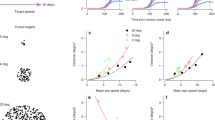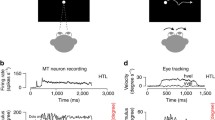Abstract
We report a model that reproduces many of the behavioral properties of smooth pursuit eye movements. The model is a negative-feedback system that uses three parallel visual motion pathways to drive pursuit. The three visual pathways process image motion, defined as target motion with respect to the moving eye, and provide signals related to image velocity, image acceleration, and a transient that occurs at the onset of target motion. The three visual motion signals are summed and integrated to produce the eye velocity output of the model. The model reproduces the average eye velocity evoked by steps of target velocity in monkeys and humans and accounts for the variation among individual responses and subjects. When its motor pathways are expanded to include positive feedback of eye velocity and a “switch”, the model reproduces the exponential decay in eye velocity observed when a moving target stops. Manipulation of this expanded model can mimic the effects of stimulation and lesions in the arcuate pursuit area, the middle temporal visual area (MT), and the medial superior temporal visual area (MST).
Similar content being viewed by others
References
Carl JR and Gellman RS (1987) Human smooth pursuit: Stimulusdependent responses. J. Neurophysiol. 5:1446–1463.
Deno DC, Keller EL, and Crandall WF (1989) Dynamic neural network organization of the visual pursuit system. IEEE Trans. Biomed. Eng. 36:85–92.
Dursteler MR, Wurtz RH, and Newsome WT (1987) Directional pursuit deficits following lesions of the foveal representation within the superior temporal sulcus of the macaque monkey. J. Neurophysiol. 57:1262–1287.
Dursteler MR and Wurtz RH (1988) Pursuit and optokinetic deficits following chemical lesions of cortical areas MT and MST. J. Neurophysiol. 60:940–965.
Goldreich D, Krauzlis RJ, and Lisberger SG (1992) Effect of changing feedback delay on spontaneous oscillations in smooth pursuit eye movements of monkeys. J. Neurophysiol. 67:625–638.
Grasse KL and Lisberger SG (1992) Analysis of a naturally occurring asymmetry in vertical smooth pursuit eye movements in a monkey. J. Neurophysiol. 67:164–179.
Heubner WP, Leigh RJ, Seidman SH, Thomas CW, Billian C, DiScenna AO, and Dell'osso LF (1992) Experimental tests of a superposition hypothesis to explain the relationship between the vestibuloocular reflex and smooth pursuit during horizontal combined eye-head tracking in humans. J. Neurophysiol. 68:1775–1792.
Kamath RY and Keller EL (1976) A neurological integrator for the oculomotor control system. Math Biosci. 30:341–352.
Keating EG (1991) Frontal eye field lesions impair predictive and visually-guided pursuit eye movements. Exp. Brain Res. 86:311–323.
Keating EG (1993) Lesions of the frontal eye fields impair pursuit eye movements, but preserve the predictions driving them. Behav. Brain Res. 53:91–104.
Komatsu H and Wurtz RH (1989) Modulation of pursuit eye movements by stimulation of cortical areas MT and MST. J. Neurophysiol. 62:31–47.
Krauzlis RJ (1991) Visual motion signals underlying pursuit eye movements in monkeys: Behavior, models, and neural responses in the cerebellum. Ph.D. Thesis, University of California, San Francisco.
Krauzlis RJ and Lisberger SG (1989) A control systems model of smooth pursuit eye movements with realistic emergent properties. Neural Comp. 1:116–122.
Krauzlis RJ and Lisberger SG (1991) Visual motion commands for pursuit eye movements in the cerebellum. Science 253:568–571.
Krauzlis RJ and Lisberger SG (1994) Temporal properties of visual motion signals for the initiation of smooth pursuit eye movements in monkeys. J. Neurophysiol. 72: 150–162.
Lisberger SG (1994) Neural basis for motor learning in the vestibulo-ocular reflex of monkeys. III. Behavioral and computational analysis of the site of learning. J. Neurophysiol. 72:974–998.
Lisberger SG, Evinger C, Johanson GW, and Fuchs AF (1981) Relationship between eye acceleration and retinal image velocity during foveal smooth pursuit eye movements in man and monkey. J. Neurophysiol. 46:229–249, 1981.
Lisberger SG and Fuchs AF (1978) Role of primate flocculus during rapid behavioral modification of vestibulo-ocular reflex. I. Purkinje cell activity during visually guided horizontal smooth pursuit eye movements and passive head rotation. J. Neurophysiol. 41:733–763.
Lisberger SG, Morris EJ, and Tychsen L (1987) Visual motion processing and sensory-motor integration for smooth pursuit eye movements. Ann. Rev. Neurosci. 10:97–129.
Lisberger SG and Movshon JA (1991) Signals encoding target acceleration in visual area MT of macaque monkeys (Abstract). Soc. Neurosci. Abstr. 17:440.
Lisberger SG and Westbrook LE (1985) Properties of visual inputs that initiate horizontal smooth pursuit eye movements in monkeys. J. Neurosci. 5:1662–1673.
Luebke AE and Robinson DA (1988) Transition dynamics between pursuit and fixation suggest different systems. Vision Res. 28:941–946.
Lynch JC (1987) Frontal eye field lesions in monkey disrupt visual pursuit. Exp. Brain Res. 68:437–441.
MacAvoy MG, Gottlieb JP, and Bruce CJ (1991) Smooth pursuit eye movement representation in the primate frontal eye field. Cerebral Cortex 1:95–102.
Maunsell JHR and Van Essen DC (1983) Functional properties of neurons in middle temporal visual area of the macaque monkey. I. Selectivity for stimulus direction, speed and orientation. J. Neurophysiol. 49:1127–1147.
May JG, Keller EL, and Crandall WF (1986) Changes in eye velocity during smooth pursuit tracking induced by microstimulation in the dorsolateral pontine nucleus of the macaque. Exp. Brain Res. 63:265–278.
Miles FA, Fuller JH, Braitman DJ, and Dow BM (1980) Long-terra adaptive changes in primate vestibulo-ocular reflex. III. Electro-physiological observations in flocculus of normal monkey. J. Neurophysiol. 43:1437–1476.
Morris EJ and Lisberger SG (1985) A computer model that predicts monkey smooth pursuit eye movements on a millisecond timescale (Abstract). Soc. Neurosci. Abstr. 11:79.
Morris EJ and Lisberger SG (1987) Different responses to small visual errors during initiation and maintenance of smooth-pursuit eye movements in monkeys. J. Neurophysiol. 58:1351–1369.
Movshon JA, Lisberger SG, and Krauzlis RJ (1990) Visual cortical signals supporting smooth pursuit eye movements. Cold Spring Harbor Symp. on Quantitative Biology 50:707–716.
Nelder JA and Mead R (1965) A simplex method for function minimization. Computer Journal, 7:308–313.
Newsome WT, Wurtz RH, Dursteler MR, and Mikami A (1985) Deficits in visual motion processing following ibotenic acid lesions of the middle temporal visual area of the macaque monkey. J. Neurosci. 5:825–840.
Newsome WT, Wurtz RH, and Komatsu H (1988) Relation of cortical areas MT and MST to pursuit eye movements. II. Differentiation of retinal from extraretinal inputs. J. Neurophysiol. 60:604–620.
Press WH, Flannery BP, Teukolsky SA, and Vetterling WT (1988) Numerical recipes in C. The art of scientific computing. Cambridge University Press, pp. 94–98.
Robinson DA (1965) The mechanics of human smooth pursuit eye movement. J. Physiol. Lond. 180:569–591.
Robinson DA (1971) Models of oculomotor neural organization. In: The Control of Eye Movements. Eds. P. Bach-y-Rita, CC Coffins, JE Hyde. Academic Press, New York and London, pp. 519–538.
Robinson DA, Gordon JL, and Gordon SE (1986) A model of the smooth pursuit eye movement system. Biol. Cybern. 55:43–57.
Schwartz JD and Lisberger SG (1994) Modulation of the gain of visuo-motor transmission during pursuit eye movements in monkeys. Visual Neuroscience, in press.
Stone LS and Lisberger SG (1990) Visual responses of Purkinje cells in the cerebellar flocculus during smooth pursuit eye movements in monkeys. I. Simple spikes. J. Neurophysiol. 63:1241–1261.
Tychsen LT and Lisberger SG (1986) Visual motion processing for the initiation of smooth-pursuit eye movements in humans. J. Neurophysiol. 56:953–968.
Young LR, Forster JD, and Van Houtte N (1968) A revised stochastic sampled data model for eye tracking movements. Fourth Ann NASA-University conference on manual control, University of Michigan, Ann Arbor Michigan.
Zee DS, Leigh RJ, and Mathieu-Millaire F (1980) Cerebellar control of ocular gaze stability. Ann Neurol. 7:37–40.
Zee DS, Yamazaki A, Butler PH, and Gucer G (1981) Effects of ablation of flocculus and paraflocculus on eye movements in primate. J. Neurophysiol. 46:878–899.
Author information
Authors and Affiliations
Rights and permissions
About this article
Cite this article
Krauzlis, R.J., Lisberger, S.G. A model of visually-guided smooth pursuit eye movements based on behavioral observations. J Comput Neurosci 1, 265–283 (1994). https://doi.org/10.1007/BF00961876
Received:
Revised:
Accepted:
Issue Date:
DOI: https://doi.org/10.1007/BF00961876




